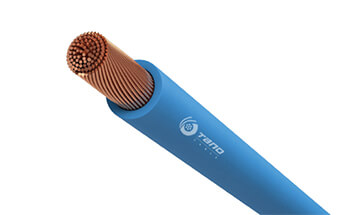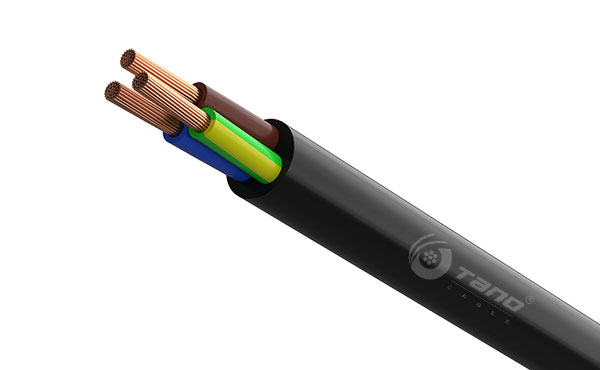19
Jun
The Conductor of Cable
Share:
The Conductor
The current-carrying conductors of submarine power cables are made of copper or aluminium. Even though copper is more expensive than aluminium in relation to the current-carrying capability, the majority of submarine power cables have copper conductors. Copper allows a smaller cross section and hence requires less material for the outer layers such as lead and steel wires. However, there are occasions where aluminium is the better solution. There is no given best choice as the costs vary strongly with a volatile metal market. The limited corrosion resistance of aluminium is sometimes quoted in favour of copper for submarine power cables. However, when seawater can cause corrosion in the conductor, it has already penetrated the insulation, and the cable must be repaired or replaced, regardless of the conductor material.
For some cable projects it makes sense to use copper for some parts of the route, and aluminium for others. The HVDC cables of the Estlink project have copper conductors in the submarine part and aluminium in the land section. It is also possible to use submarine cables with aluminium conductor for the deeper cold part of the submarine cable route and “copper ends” for the warmer parts buried close to the beach. Copper and aluminium conductors can be jointed together.
Conductors of submarine power cable are made in various shapes. The most common shapes are explained below.
Solid Conductor
The conductor consists of a single massive wire. This design is used for cross sections up to about 400 mm2. The manufacturing is easy and the conductor has naturally good longitudinal water tightness, a property most often required for submarine cables. Sometimes an extruded insulation tends to slip on the smooth conductor surface thus creating a shrink-back tendency of the insulation when cutting the cable for termination or jointing. This phenomenon depends largely on the extrusion technique for the insulation. Knurling or similar surface treating methods on the conductor can enhance friction and reduce shrink-back problems.
As the cross-section of solid conductors is limited to about 400 mm2, they are not used for cables >150 kV, which usually have larger cross sections. For low voltage cables with three or four cores in one cable, also segment-shaped solid conductors are used.
Conductors Stranded from Round Wires
Most conductors for submarine power cables are stranded from round wires. The wires are laid up in the stranding machines in layers. The conductor is compressed by the action of dies or roller sets, either after each layer or at the end of the stranding machine. The compressing reduces the interstices between the strands. Conductors from compressed round wires can achieve a filling factor of 92%. Since the wires are cold worked by the compression, the electric conductivity of the material is reduced.
There are two different stranding directions: righthand or left hand. Sometimes they are denominated as Z-lay or S-lay, depending on the visual impression of the spiralled strands. Imagine that the letter is projected onto the lay and find out if the central line of the letter goes in parallel with the strand lay. The sketch shows a Z-laid conductor. Most often, the layers of stranded conductors have alternatively S- and Z-lay, but it is possible to use any mixture of lay directions for better stability of the conductor or other production reasons. For any practical reason, the conductivity of the conductor is not depending on the sequence of S- and Z-lay. If the cable is to be coiled in clockwise direction the outer conductor layer should be laid right-hand (Z-lay) so that the conductor contracts during coiling. A conductor expanding under the influence of the coiling stress would possibly infringe with the insulation. In paper-insulated cables the innermost paper layers can burst.
Conductors with compressed round wires are equally useful for a.c. and d.c. applications. Most often, they are designed according to the industrial standard IEC 60228, Class 2. For large cross sections or transmission power, d.c. cables would be more economic with profiled wire conductors, and a.c. cables would be more economic with Milliken conductors which are described later.
In large conductors for a.c. cable additional magnetic losses can be generated reducing the ampacity of the cable. The “proximity effect” in a conductor is caused by the magnetic field of neighbour cables and tends to “push” the current flow lines into a certain part of the conductor. Individual wires or groups of wires can be insulated electrically to reduce the “proximity effect”. The insulation can be accomplished by paper or plastic strips, or by varnish coatings of the wires. Another magnetic effect, the “skin effect” cannot be reduced by this method in normal stranded conductors.
Tinned copper wires have been used frequently for conductor manufacturing in earlier times, but this concept has not been pursued in the recent years.
The current-carrying conductors of submarine power cables are made of copper or aluminium. Even though copper is more expensive than aluminium in relation to the current-carrying capability, the majority of submarine power cables have copper conductors. Copper allows a smaller cross section and hence requires less material for the outer layers such as lead and steel wires. However, there are occasions where aluminium is the better solution. There is no given best choice as the costs vary strongly with a volatile metal market. The limited corrosion resistance of aluminium is sometimes quoted in favour of copper for submarine power cables. However, when seawater can cause corrosion in the conductor, it has already penetrated the insulation, and the cable must be repaired or replaced, regardless of the conductor material.
For some cable projects it makes sense to use copper for some parts of the route, and aluminium for others. The HVDC cables of the Estlink project have copper conductors in the submarine part and aluminium in the land section. It is also possible to use submarine cables with aluminium conductor for the deeper cold part of the submarine cable route and “copper ends” for the warmer parts buried close to the beach. Copper and aluminium conductors can be jointed together.
Conductors of submarine power cable are made in various shapes. The most common shapes are explained below.
Solid Conductor
The conductor consists of a single massive wire. This design is used for cross sections up to about 400 mm2. The manufacturing is easy and the conductor has naturally good longitudinal water tightness, a property most often required for submarine cables. Sometimes an extruded insulation tends to slip on the smooth conductor surface thus creating a shrink-back tendency of the insulation when cutting the cable for termination or jointing. This phenomenon depends largely on the extrusion technique for the insulation. Knurling or similar surface treating methods on the conductor can enhance friction and reduce shrink-back problems.
As the cross-section of solid conductors is limited to about 400 mm2, they are not used for cables >150 kV, which usually have larger cross sections. For low voltage cables with three or four cores in one cable, also segment-shaped solid conductors are used.
Conductors Stranded from Round Wires
Most conductors for submarine power cables are stranded from round wires. The wires are laid up in the stranding machines in layers. The conductor is compressed by the action of dies or roller sets, either after each layer or at the end of the stranding machine. The compressing reduces the interstices between the strands. Conductors from compressed round wires can achieve a filling factor of 92%. Since the wires are cold worked by the compression, the electric conductivity of the material is reduced.
There are two different stranding directions: righthand or left hand. Sometimes they are denominated as Z-lay or S-lay, depending on the visual impression of the spiralled strands. Imagine that the letter is projected onto the lay and find out if the central line of the letter goes in parallel with the strand lay. The sketch shows a Z-laid conductor. Most often, the layers of stranded conductors have alternatively S- and Z-lay, but it is possible to use any mixture of lay directions for better stability of the conductor or other production reasons. For any practical reason, the conductivity of the conductor is not depending on the sequence of S- and Z-lay. If the cable is to be coiled in clockwise direction the outer conductor layer should be laid right-hand (Z-lay) so that the conductor contracts during coiling. A conductor expanding under the influence of the coiling stress would possibly infringe with the insulation. In paper-insulated cables the innermost paper layers can burst.
Conductors with compressed round wires are equally useful for a.c. and d.c. applications. Most often, they are designed according to the industrial standard IEC 60228, Class 2. For large cross sections or transmission power, d.c. cables would be more economic with profiled wire conductors, and a.c. cables would be more economic with Milliken conductors which are described later.
In large conductors for a.c. cable additional magnetic losses can be generated reducing the ampacity of the cable. The “proximity effect” in a conductor is caused by the magnetic field of neighbour cables and tends to “push” the current flow lines into a certain part of the conductor. Individual wires or groups of wires can be insulated electrically to reduce the “proximity effect”. The insulation can be accomplished by paper or plastic strips, or by varnish coatings of the wires. Another magnetic effect, the “skin effect” cannot be reduced by this method in normal stranded conductors.
Tinned copper wires have been used frequently for conductor manufacturing in earlier times, but this concept has not been pursued in the recent years.
Previous article:
Next article:







